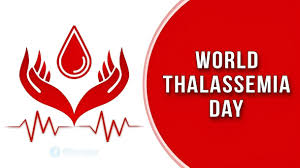World Thalassaemia Day:

World Thalassaemia Day is observed on May 8 every year to raise awareness and promote action around the genetic disorder that affects millions of people worldwide.
- Thalassemia is an inherited blood disorder.
- Thalassemia causes the body to have less of the protein hemoglobin than usual.
- Hemoglobin is present in red blood cells and allows the red blood cells to carry oxygen.
- Not having enough hemoglobin or red blood cells can lead to a condition called anemia. That can make you feel tired and weak.
- Thalassaemia is caused by inheriting a gene mutation (change in the normal DNA) from one or both parents.
- There are different types of thalassaemia. The type someone has depends on which gene mutation they inherit.
- Symptoms: Thalassemia can cause mild or severe anemia and other complications over time (such as iron overload).
- Treatments: Blood transfusions – regular blood transfusions treat and prevent anaemia; in severe cases these are needed around once a month. Chelation therapy – treatment with medicine to remove the excess iron from the body that builds up as a result of having regular blood transfusions .The only possible cure for thalassaemia is a stem cell or bone marrow transplant, but this is not done very often because of the risks involved.




